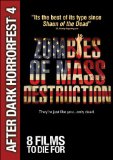The year is 2003. The War in Iraq is just underway, and its ripples are felt even in the small town of Port Gamble, Washington. Take, for instance, Frida (Janette Armand). Her father is Iranian, which is the same thing as Iraqi as far as everyone else is concerned, and furthermore her skin tone and ethnic background mean she is not a “real American” (to quote her numbskulled boyfriend) even though she was born in Port Gamble. Tom (Doug Fahl), meanwhile, has concerns less related to world affairs: he has returned to his home town, in the company of his boyfriend Lance (Cooper Hopkins), to come out to his mother, a prospect that fills him with dread. Then, just to complicate everybody’s life, a zombie plague breaks out, bringing out the best and worst of everyone in town.
Zombies have been fodder for socio-political allegory all the way back to their first cinematic appearance (in their pre-flesh-eating days) in White Zombie (1932), where they were the exploited workers of Bela Lugosi’s sugar cane mill. Director Kevin Hamedani and his co-writer Ramon Isao go into satirical overdrive with this effort. There is some very funny stuff here, along with plenty of over-the-top gore FX and likable protagonists. Unlike Dawn of the Dead and Shaun of the Dead, however, whose commentary emerges naturally from the story and characters, here the personalities and story have clearly been designed to fit the political points being made. Thus, though Frida, Tom and Lance are very engaging characters (if almost entirely defined by their ethnic or sexual minority identities), their non-zombified opponents are caricatures of conservatism, as hissable as they are stupid. Now, satire is, by its very nature, a savage art, and I’m all for both savagery and movies that aren’t afraid to take a stand, but Hamedani and Isao run the risk of preaching to the choir here. With almost every line of dialogue slaved to the film’s political points, we are entering the realm of the editorial cartoon. And though there’s nothing wrong with that, it does mean that there isn’t much to the film beyond those political points. Thus, one faction of the audience will simply have its views confirmed, while the other will be completely alienated, and it is doubtful that much thought will be provoked. As well, some of the gags are arguably a bit misjudged. The scene where Tom’s mother eats her own eye owes its funny/nauseating vibe to Peter Jackson’s Dead/Alive, and works well enough, but the moment where a little girl Frida is trying to help is splattered by a car is more problematic, depending on your tolerance for extreme splatstick. All that said, there’s still plenty of sharp work from all concerned here.
Video
The palette is a naturalistic one, favoring realism over eye candy. The colours are solid, as are the contrasts, blacks and flesh tones. The overall look is a perhaps a bit darker than it needs to be, which makes for some squint-inducing moments in a few of the night scenes. Grain is not a problem, though, and the image is nicely sharp. The aspect ratio is 1.78:1 anamorphic widescreen.
Audio
There’s a great Goblin-like feel to the electronic score, and it makes full use of surround possibilities. The sound effects are also well handled, so be prepared to hear gut-munching coming at your from all sides. The dialogue is always clear and never drowned out, however energetic the rest of the track becomes. Very nice work, then, and as slick as that on films considerably more expensive than this.
Special Features
The Making of Zombies of Mass Destruction: (6:00) The usual promotional thing, and pretty brief at that, though it is interesting to hear the filmmakers talk about the film’s politics.
Original Trailer.
Final Thoughts
This is energetic, committed filmmaking that goes for the political jugular. But repeatedly hammering the same point home can grow numbing, and, unlike this film’s models, there isn’t the meat here that rewards repeated viewings.






